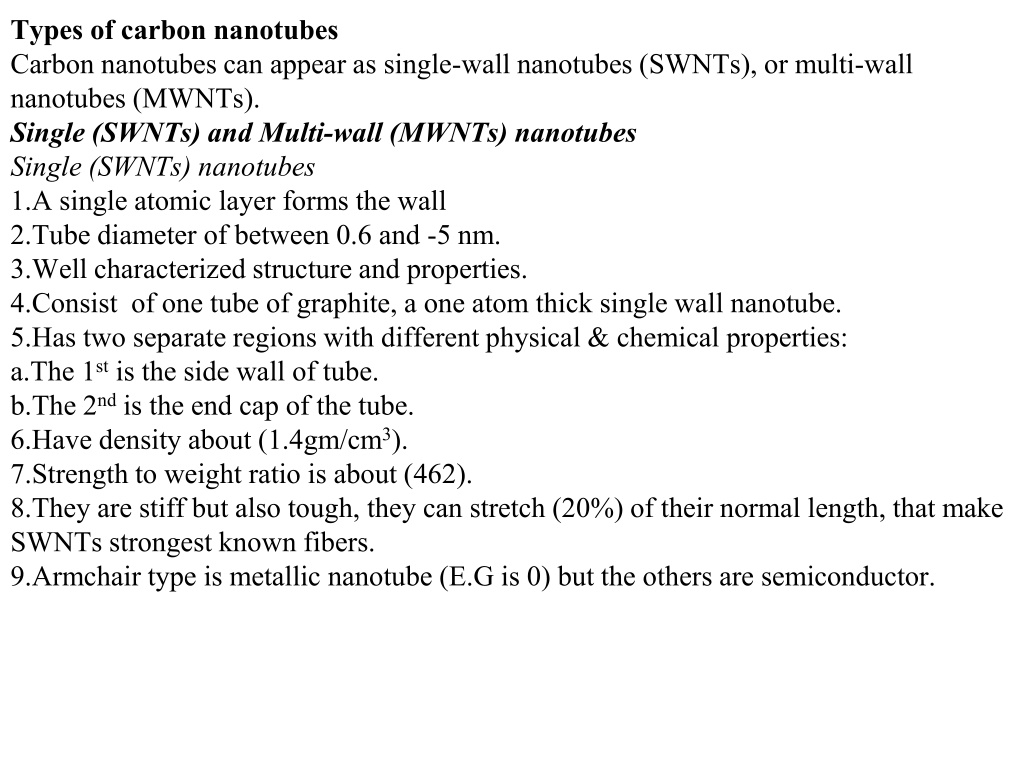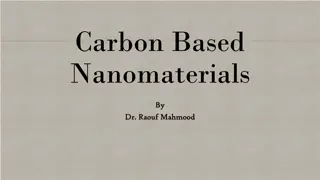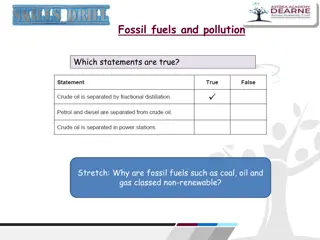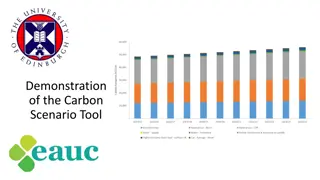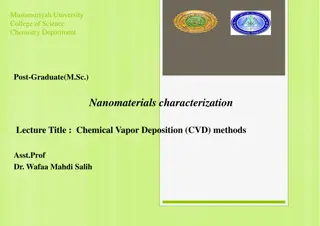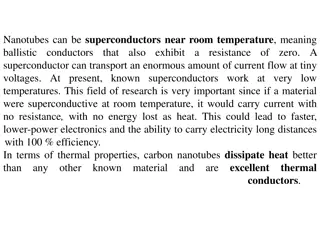Understanding Different Types of Carbon Nanotubes
Carbon nanotubes come in single-wall (SWNTs) and multi-wall (MWNTs) forms, each with unique characteristics. SWNTs have a single atomic layer forming the wall, while MWNTs consist of concentric tubes. SWNTs are stronger and mostly semiconductors, while MWNTs are less strong and can also be semiconductors. Graphene production methods also yield different types of carbon nanotubes. The structures of carbon nanotubes can vary, with chiral structures being common.
Download Presentation

Please find below an Image/Link to download the presentation.
The content on the website is provided AS IS for your information and personal use only. It may not be sold, licensed, or shared on other websites without obtaining consent from the author. Download presentation by click this link. If you encounter any issues during the download, it is possible that the publisher has removed the file from their server.
E N D
Presentation Transcript
Types of carbon nanotubes Carbon nanotubes can appear as single-wall nanotubes (SWNTs), or multi-wall nanotubes (MWNTs). Single (SWNTs) and Multi-wall (MWNTs) nanotubes Single (SWNTs) nanotubes 1.A single atomic layer forms the wall 2.Tube diameter of between 0.6 and -5 nm. 3.Well characterized structure and properties. 4.Consist of one tube of graphite, a one atom thick single wall nanotube. 5.Has two separate regions with different physical & chemical properties: a.The 1stis the side wall of tube. b.The 2ndis the end cap of the tube. 6.Have density about (1.4gm/cm3). 7.Strength to weight ratio is about (462). 8.They are stiff but also tough, they can stretch (20%) of their normal length, that make SWNTs strongest known fibers. 9.Armchair type is metallic nanotube (E.G is 0) but the others are semiconductor.
Multi-wall (MWNTs) nanotubes . Inner diameter: 1.5 15 nm. . Outer diameter: 2.5 50 nm 50 layers. . Many structural defects. . Consist of a number of concentric tubes. . The inter layer distance is closed to the distance between graphene layers in graphite which equal to (3.3Ao). . Density about (1.8 gm/cm3). . Not stronger than SWNTs. . They can be semiconductors where the E.G. is about (2.3 - 4 eV).
Fig. (6) Graphene production method., CNT come in different types and thicknesses - multi wall, single wall, stacked cup, etc. Graphene is flat and much better for formulating thermally conductive materials.
Structure of carbon nanotubes * In the theoretical analysis of carbon nanotubes, the major focus has been on single-walled tubes, cylindrical in shape with caps at each end, such that the two caps can be joined together to form a fullerene. The cylindrical portions of the tubes consist of a single graphene sheet (a single layer of carbon atoms from a three dimensional graphite crystal) that is shaped to form the cylinder. There are two possible high - symmetry structures for nanotubes, known as zigzag and armchair . In practice, it is believed that most nanotubes do not have these highly symmetric forms but have structures in which the hexagons are arranged helically around the tube axis. These structures are generally known as chiral , because they can exist in two mirror-related forms (Fig. 7).
Fig(7 ) Illustration of some possible structures of carbon nanotubes, depending on how graphite sheets are rolled: (a) armchair structure; (b) zigzag structure; (c) chiral structure.
* It is convenient to describe a carbon nanotube in terms of the chiral vector, ?h, and the chiral angle, q , as shown in this Fig. 6. The points, O, and A, are crystallographically equivalent on the graphene sheet. These points are connected by the chiral vector, ?h, which is defined in terms of the basis vectors, ?1and ?2, of the honeycomb lattice.
where n and m are integers. The chiral angle, q , is shown in the figure. OB represents the normal to ?hat point O. Depending on the value of the chiral angle, a single-walled carbon nanotube can have three basic geometries: armchair, zigzag and chiral, as illustrated in the Fig. 6. * The diameter of a carbon nanotube is given by,
The integers n and m uniquely determine dt and q . . * The circumference of the nanotube is given by where a is the length of unit vector
